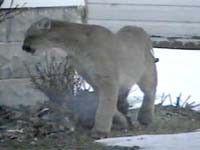
June 10, 2006

This is a frame from the video of a cougar taken in Willmar, Minnesota, which lead to the capture of the animal on February 1, 2006. Most people didn’t believe the reported cat was anything more than a figment of people’s imagination before the video.
Meanwhile hundreds of miles away, officials in other locations are confronted with similar situations with less imagery. Nevertheless, sometimes it becomes “official business,” merely based on the where and the who of the encounters. Take, for instance, the events unfolding now in Kentucky.
What happens when the United States federal government has to deal with mysterious cryptid cat sightings in the midst of a national park, in an area where these large felids are not officially verified? And the eyewitnesses include park employees? They issue a press release, of course, as per the following, to attempt to explain the situation to a wondering public:
Mammoth Cave National Park Superintendent Patrick Reed announced on June 7, 2006, that reports of cougar sightings within the park have increased in the past nine months. Three reports have been received since September 2005.
“Right now, we don’t have a lot of information,” said Reed. “These are only sightings. We have not recovered any hard evidence of a cougar in the park. The existence of a cougar in Mammoth Cave National Park would be unusual because we are hundreds of miles from where cougars are known to exist. However, for the safety of our visitors, employees, and park neighbors, we’d like to make them aware of the sightings.”
Park staff are in consultation with state and federal officials regarding the likelihood of a native cougar (Puma concolor, also known as mountain lion, puma, panther and catamount) immigrating into the area, or the possibility of a non-native animal being illegally released here. In addition, park staff are attempting to confirm these sightings by obtaining credible field evidence – photo, scat, hair, tracks, or an animal killed by a cougar. Presently, cougar populations can be found in southern Florida, from the Rocky Mountains west to the Pacific coast, the Dakotas, Missouri, and south Texas. Male cougars appear to be expanding their range eastward towards the Mississippi River. A single male cougar’s home range can be from 125 square miles to 175 square miles – Mammoth Cave National Park is 80 square miles.
Park staff are also compiling a list of safety tips based on those used in National Park Service areas where cougars are present:
Always hike, backpack, and camp with a companion. Be aware of your surroundings.
If you see a cougar, make eye contact and stand your ground. Make yourself appear large by shouting and waving your arms. Do not bend over or crouch down. Back away slowly – never run from a cougar; this may trigger their instinct to chase. Fight back aggressively if attacked.
Supervise children closely. Don’t allow them to run ahead or lag behind.
“There have been isolated reports of cougars in the park since the 1960s,” added Reed. “The frequency of the recent cougar sightings, and the fact that some of the reports came from our own staff, has raised our level of attention. If there is a cougar using the park, the level of risk to humans is likely to be very low. Mammoth Cave National Park is a natural place – it is not tame. Be aware and respectful of all the park inhabitants – butterfly or tick, wildflower or poison ivy, raccoon or possibly a cougar.”
(News release courtesy of The National Park Service.)
About Loren Coleman
Loren Coleman is one of the world’s leading cryptozoologists, some say “the” leading living cryptozoologist. Certainly, he is acknowledged as the current living American researcher and writer who has most popularized cryptozoology in the late 20th and early 21st centuries.
Starting his fieldwork and investigations in 1960, after traveling and trekking extensively in pursuit of cryptozoological mysteries, Coleman began writing to share his experiences in 1969. An honorary member of Ivan T. Sanderson’s Society for the Investigation of the Unexplained in the 1970s, Coleman has been bestowed with similar honorary memberships of the North Idaho College Cryptozoology Club in 1983, and in subsequent years, that of the British Columbia Scientific Cryptozoology Club, CryptoSafari International, and other international organizations. He was also a Life Member and Benefactor of the International Society of Cryptozoology (now-defunct).
Loren Coleman’s daily blog, as a member of the Cryptomundo Team, served as an ongoing avenue of communication for the ever-growing body of cryptozoo news from 2005 through 2013. He returned as an infrequent contributor beginning Halloween week of 2015.
Coleman is the founder in 2003, and current director of the International Cryptozoology Museum in Portland, Maine.
Filed under Alien Big Cats, Breaking News, Cryptotourism, CryptoZoo News, Cryptozoology, Eyewitness Accounts, Mystery Cats